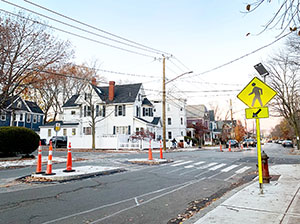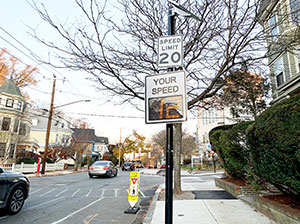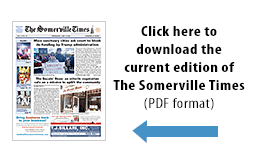
A pedestrian refuge island at the intersection of College Ave. and Kidder Ave. in Somerville. — Photos by Melina Nguyen
By Melina Nguyen
Drivers, cyclists and pedestrians travel every day on Somerville’s maze-like streets. According to some, the city haphazardly jumbles together commuters who walk, bike or drive, and pedestrians and cyclists face possible danger at every crosswalk.
Last November, a beloved neighborhood doctor, Leah Zallmann, 40, died at the intersection of College and Kidder avenues.
This tragic accident spurred community advocacy for pedestrian safety. Safety advocates in Somerville believe the city can prevent accidents by implementing unique street features, physical separation between roads and bike lanes, and strict speed limits.
Earlier this year, the Somerville Alliance for Safe Streets was created to ensure “safety and equitable mobility for all,” according to Ward 5 City Councilor Mark Niedergang.
Six pedestrians have been killed by motor vehicles since 2019, according to preliminary Year To Date (YTD) motor vehicle fatality information on the Massachusetts Department of Transportation website.

A radar speed sign on College Ave. clocks the speeds of incoming cars in Somerville.
Niedergang said he helped create SASS to address street safety concerns after seeing these fatalities. “This is not inevitable,” he said. “We can avoid this kind of thing happening by the way that we build our streets, and we need to redo a lot of our streets so that pedestrians don’t get killed and injured by a motor vehicle.”
Although severe crashes have been trending downward over the past decade, a small uptick in fatal pedestrian and cyclist incidents was observed in 2019 and 2020, according to the 2020 VisionZero report card, a campaign focused on lowering the number and severity of pedestrian accidents on roads.
Chris Dwan, a Somerville resident and member of SASS, sees accessibility and equitable usage as a priority. “Everyone should be safe,” he said. “Physical safety comes first for everybody, able-bodied and disabled.”
The speed of vehicles is the most important factor in fatal pedestrian accidents, said Dwan.
The average pedestrian has about a 40 percent higher chance of survival after being struck by a car at 20 mph compared to 40 mph, according to an investigative interactive graph made with data from the AAA Safety Foundation and produced by the news nonprofit ProPublica.
Somerville enacted a 25 mph speed limit in November 2016. Some areas with safety zone signs have a lower speed limit of 20 mph.
SASS presented a design guide with recommended street safety features to city committees, which endorsed the guide and made it easier for the mayor and city council to review.
The street features include pedestrian refuge islands, speed humps, separated bike lanes and concurrent automatic crosswalk signals with no buttons. These recommendations help pedestrians cross the street safely by reducing the speed of cars and the proximity of cars to people.
In Somerville, 25 percent of the surface area is roads, said Dwan. The recommended street features place an emphasis on physical barriers, like the refuge islands, which can be built in the middle of wide streets and provide a place for pedestrians to stop if they cannot cross during one walk signal cycle.
However, the physical barriers create an unforeseen consequence: inhibiting pickup and drop off and deliveries in places such as Beacon Street. Therefore, it is important to “have all viewpoints,” said Dwan.
Some troublesome streets that need more pedestrian-friendly features include the Alewife-Brook Parkway, a wide, heavily-trafficked state road that connects Arlington, Somerville and Cambridge, and Mystic Avenue, McGrath O’Brien Highway, and Interstate 93 junction, which was the location of a rally organized by SASS earlier this year.
Dwan is also a part of Vision Zero which releases regular report cards that track the current and future progress of the Vision Zero goals, including a data-driven framework that helps leaders design and operate safe streets.
Dwan anticipates 2022 will be “exciting” in terms of potential traffic safety improvements. Coalitions like SASS are working towards further improvements based on the design guide, introducing community experts and their recommendations to elected officials and adopting a more “regional” mindset when it comes to road safety.
As a whole, Somerville has seen many improvements to its streets with the help of SASS and Vision Zero.
Alex Zielke, a Davis Square resident, has friends who were involved in crashes while cycling. “I do have a few friends who have been struck while biking,” he said. “In both cases, it was a car turning right that did not check to see that there was a cyclist next to their car.”
Zielke, who works from home and travels primarily by walking, said his own issues with traffic safety have been mostly addressed and corrected. “The things that I have had issues with, the city is already working to fix them,” he said. “They’re adding more crosswalks on Holland Ave. I feel like the city generally pays attention.”















As a daily cyclist and occasional driver in Somerville, I feel these new developments are, for the most part, a mistake. The separate bike lanes send bikes through the gutter, with debris, large puddles, poor pavement and ice, which are not present in the main travel lanes. When the lanes send cyclists onto the sidewalk, the pavement is also poor compared to the main road, and the cyclists now must run the gauntlet of oblivious pedestrians. I had too many close calls on these lanes, and now boycott them for my own safety. Bikes should be kept with cars, not pedestrians.
Car traffic through the city has slowed to a crawl due to the lane reductions and extra pedestrian and right-turn phases being added to traffic lights.
While there are some good improvements, such as the back-in angled parking and pedestrian islands, I’d rather see things like awareness, signalling, eye contact, and on-road communication promoted, rather than completely trying to remove the human element in favor of ever-increasing regimentation.
Alex M
Thx for the article! I’m an avid walker, often with my kids. I drive too, for local trips across town. My biggest fears as a pedestrian are drivers running red lights, not stopping at crosswalks, and not fully stopping at stop signs. All of these are violations that can easily be enforced including through automated ticketing. Why doesn’t the city implement such ticketing? For every hour of walking I can easily spot 8+ driving violations. Drivers need more enforcement and motivation to learn to respect the right of way of pedestrians. Driving is a privilege not a right!
Here’s an idea, put some of the elevated pavement speed bump things in. People speed down our street constantly. I asked the city to put one in and they sent me a bunch of forms to do the work for them, and that was that. The city has no interest in this cheap and easy way to slow traffic to the defined speed limits. I have not seen any speed measuring counters (they look like a hose in the road) for the 10 years I have been here, in Davis or Union – or any other part of Somerville.
JT – keep working with the city for some speed bumps. The city just installed a bunch on Morrison, Kidder, and Lowell St, and it’s the first use of speed bumps (technically humps) in Somerville in a long time (except the ones on Powder House, which the city put in after a crash). It seems like city admins have turned a corner in what they’re willing to do. I’m not sure why, and I’m not sure whether it will change with the new administration. But file your traffic calming petition! Morrison, Lowell, and Kidder apparently all had petitions previously filed. I can tell you that speed humps seem to have made a huge difference for speeding. Highly recommend! https://www.somervillema.gov/sites/default/files/traffic-calming-request-form.pdf
I’m all in favor of most things that get drivers stopping for red lights and pedestrians and driving at safe speeds. However, and not to detract from anyone’s victimness at a time when the name of the game is out-victiming each other, every recent pedestrian fatality I remember reading about was caused when a pedestrian, with the right of way, stepped in front of a moving car on the assumption the car driver would see them, recognize the right of way to which they were clearly entitled, and stop for them, when in fact the driver, being a human being and thus flawed, didn’t see said pedestrian and kept on driving, leaving the recourseless pedestrian with nothing to do but get driven over (apologies for the run on sentence, or should I say, run over sentence). Focusing on speed in those situation is kind of like solving gun violence by making bullets slower.
A lot of this other infrastructure mumbo jumbo is nice and certainly pat-ourselves-on-the-back worthy, but won’t do anything for that underlying scenario. I don’t have a great solution for that, but in the meantime what I do to keep myself safe when crossing streets is wait for cars to stop before stepping in front of them. When they don’t, I wish they’d get hit by a meteor.